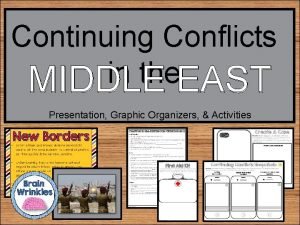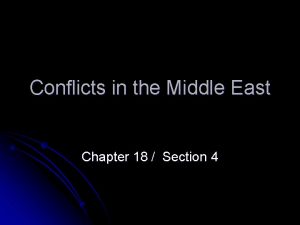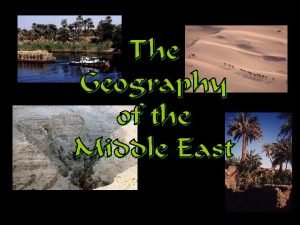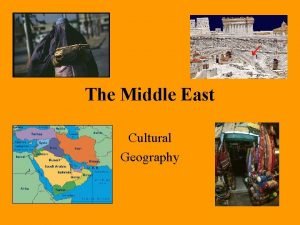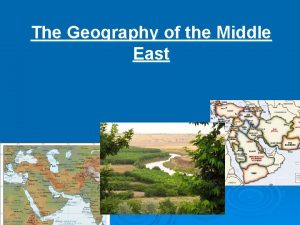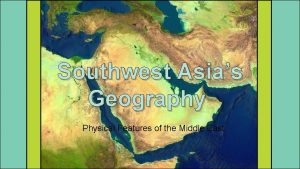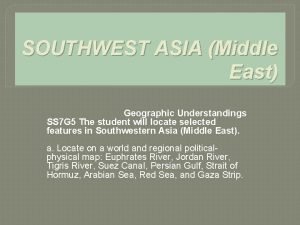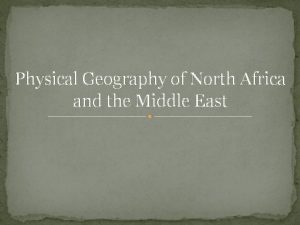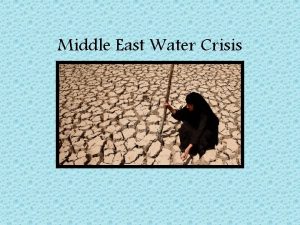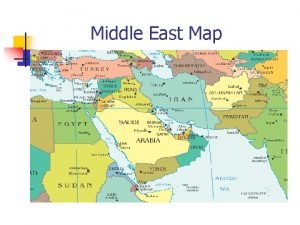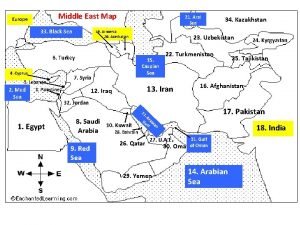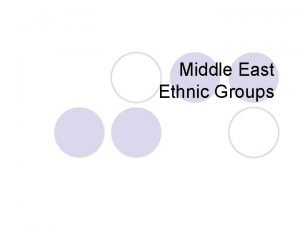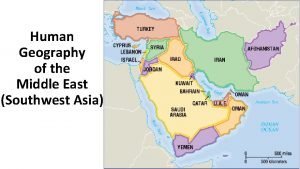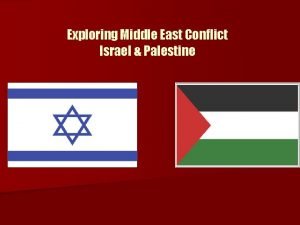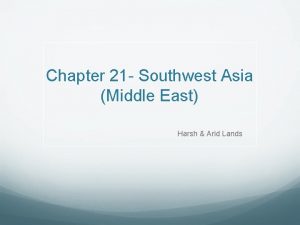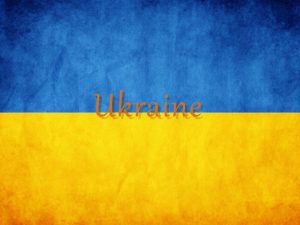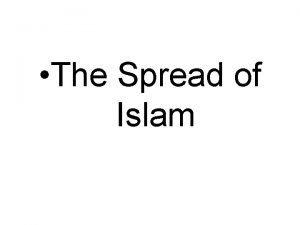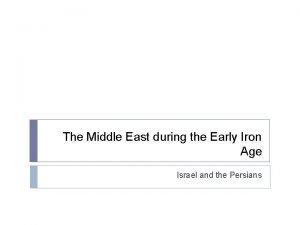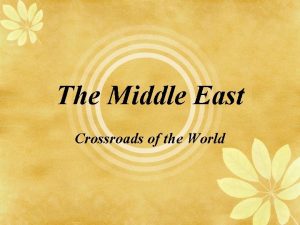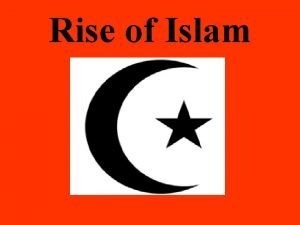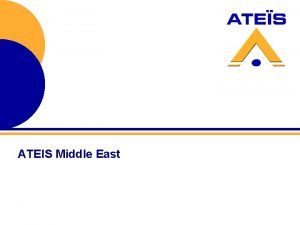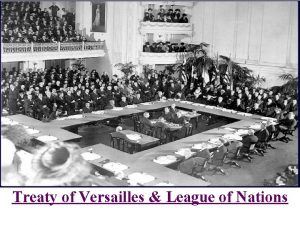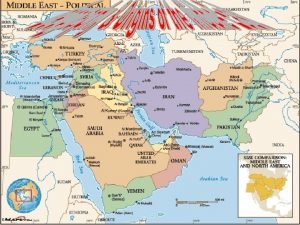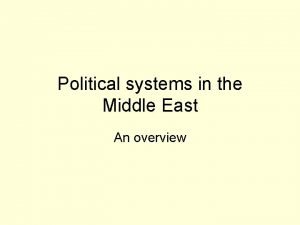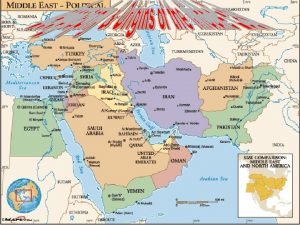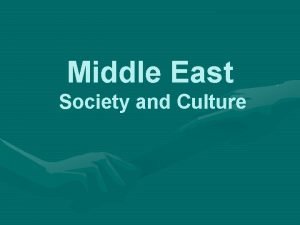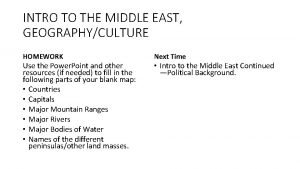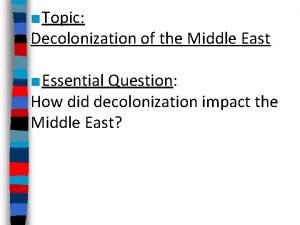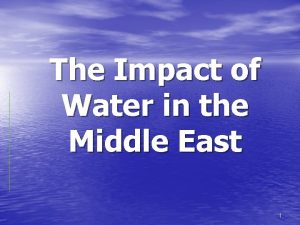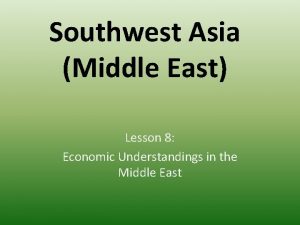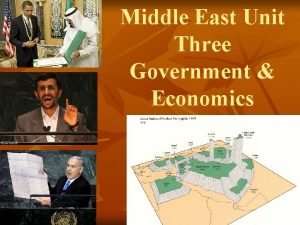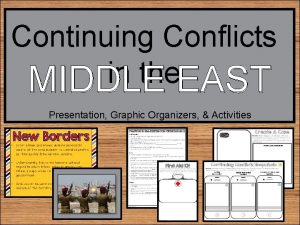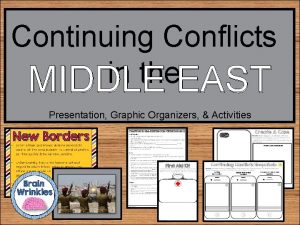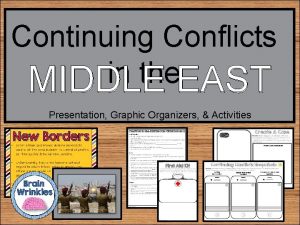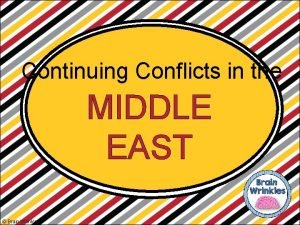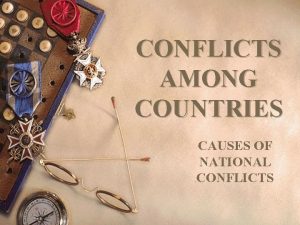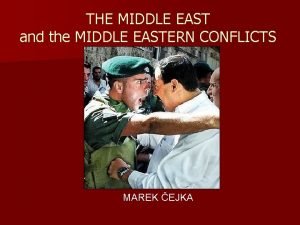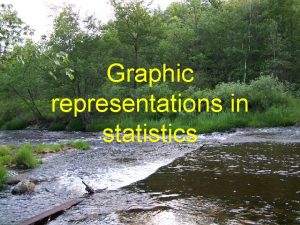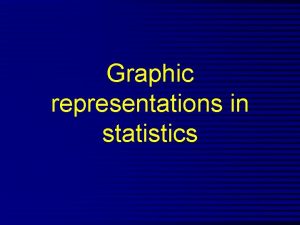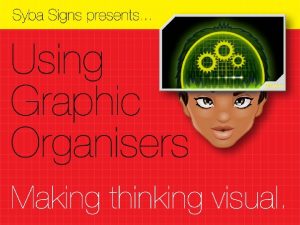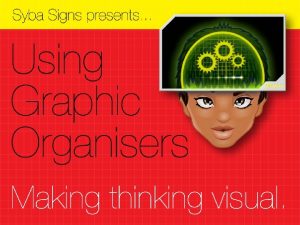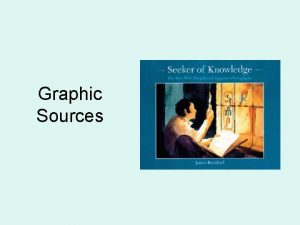Continuing Conflicts in the MIDDLE EAST Presentation Graphic











































- Slides: 43

Continuing Conflicts in the MIDDLE EAST Presentation, Graphic Organizers, & Activities

STANDARDS: SS 7 H 2 Analyze continuity and change in Southwest Asia (Middle East). a. Explain how European partitioning in the Middle East following WWI led to regional conflict. c. Describe how land religion plays a role in continuing conflicts in the Middle East (i. e. the Palestinian-Israeli conflict, the division between Sunni and Shia Muslims, and Kurdish nationalism). © Brain Wrinkles

TEACHER INFO: CLOZE Notes • The next pages are handouts for the students to use for note-taking during the presentation. (Print front to back to save paper and ink. ) • Check the answers as a class after the presentation. © Brain Wrinkles

Conflicts in the Middle East CLOZE Notes 1 Ottoman Empire • The Ottoman Turks were known for their ruthless _____________. • At its height, the Ottoman Empire was six times the _____________. • Its lands stretched from what is now Turkey and parts of southeastern Europe, northern Africa, and _____________. Collapse • Over time, the Ottoman sultans were not very capable of ruling and the empire _____________. • During World War I, the Ottoman Empire sided with the Central Powers, who ended up _____________. • Afterwards, the government collapsed and the land of the former Ottoman Empire was divided among the _____________. • The League of Nations gave France and Great Britain _____________ the Ottoman territory. Partitioning • After partitioning, France took control of Syria, Lebanon, Algeria, _____________ , and Tunisia. • The British were in charge of Egypt, _____________ , Palestine, Jordan, and a chunk of Saudi Arabia. • Great Britain heavily _____________ that were put in place in the territories it controlled, and for years, these countries remained under British supervision. • The _____________ by this land division have persisted in the Middle East today. New Borders • Great Britain and France desired immediate control of the area in order to _____________ , so they quickly drew up new borders. • Unfortunately, they drew borders without regard to which tribes, religious groups, and ethnic groups would be forced _____________. • Arab countries _____________ about the division of the territory. © Brain Wrinkles

Conflicts in the Middle East CLOZE Notes 2 Land Disputes • As they divided the land, they drew borders that _____________ to local cultures. • This caused some ethnic and religious groups to be separated by boundaries, while other rival groups were _____________. • Claims over land led to long periods of _____________ in the region. • For example, from 1980 to 1988, Iran and Iraq _____________ over disputed oil-rich territory Kurds • Another problem created by the land division has impacted _____________ , an ethnic group that have lived in the region for centuries. • Despite their large population, Kurds did not get their _____________ when Europeans partitioned the Middle East. • The Kurds were divided between _____________ , Iran, Syria, and Iraq. • These countries are uneasy with the vibrant ethnic group and _____________ them with an iron fist. • The Kurds were not given their own homeland, which has left the Kurdish people vulnerable to _____________. • Throughout the last decades of the 20 th century, Iraq’s former dictator Saddam Hussein _____________ his country’s Kurdish population. • Today, Kurds are suffering greatly from _____________. Religion • _____________ also lie at the heart of the continuing conflict in the region. • Some of the conflicts started when Europeans took control of the region, while others _____________ long before Europeans came. • The hostility between _____________ , and among different Islamic factions, forms the basis of the region’s modern history. © Brain Wrinkles

Conflicts in the Middle East CLOZE Notes 3 Palestine & Israel • In 1948, the United Nations _____________ into the Jewish nation of Israel and the Arab Muslim state of Palestine. • Palestinians refused to _____________ as a nation and as soon as it was established, fighting broke out. • Palestine, with help from the neighboring Arab countries of Lebanon, Syria, Jordan, Egypt, and Iraq, _____________ with Israel that has lasted for decades. • Arab nations do not recognize Israel as a nation, and Jewish Israel lives in _____________ from its neighbors. • There is constant conflict between Palestinians and Israelis living in the area called the _____________. • The land in Israel is _____________ Jews and Muslims, so the two groups are constantly fighting over it. Shia & Sunni • Many conflicts also occur within the _____________ in Southwest Asia. • As a result of European partitioning after WWI, Sunni and Shia Muslims, who were often rivals, were now _____________ together in one country (Iraq). • The two religious groups have fought for _____________ for decades. • The more aggressive Iraqi Sunnis _____________ with the Iranian Shiites. • In 1979, fundamentalist Muslims _____________ and imposed a strict interpretation of Islamic law on all of the country’s citizens. • Since then, they have worked hard to remove all influences of _____________. © Brain Wrinkles

Continuing Conflicts in the MIDDLE EAST © Brain Wrinkles

Ottoman Empire • The Ottoman Turks were known for their ruthless pursuit of land. • At its height, the Ottoman Empire was six times the size of Texas. • Its lands stretched from what is now Turkey and parts of southeastern Europe, northern Africa, and southwestern Asia.

© Brain Wrinkles

Collapse • Over time, the Ottoman sultans were not very capable of ruling and the empire began to decline. • During World War I, the Ottoman Empire sided with the Central Powers, who ended up losing the war. • Afterwards, the government collapsed and the land of the former Ottoman Empire was divided among the victorious European countries. • The League of Nations gave France and Great Britain control of partitioning the Ottoman

Partitioning • After partitioning, France took control of Syria, Lebanon, Algeria, Morocco, and Tunisia. • The British were in charge of Egypt, Iraq, Palestine, Jordan, and a chunk of Saudi Arabia. • Great Britain heavily influenced the governments that were put in place in the territories it controlled, and for years, these countries remained under British supervision. • The problems created by this land division have persisted in the Middle East today.

© Brain Wrinkles

New Borders • Great Britain and France desired immediate control of the area in order to control oil profits, so they quickly drew up new borders. • Unfortunately, they drew borders without regard to which tribes, religious groups, and ethnic groups would be forced under one government. • Arab countries were not consulted about the division of the territory.

Land Disputes • As they divided the land, they drew borders that paid no attention to local cultures. • This caused some ethnic and religious groups to be separated by boundaries, while other rival groups were grouped together. • Claims over land led to long periods of conflict and bloodshed in the region. • For example, from 1980 to 1988, Iran and Iraq fought a war over disputed oil-rich territory.

Iraqi soldiers pose in front of a bulletriddled mural of the Iranian leader. © Brain Wrinkles

Kurds • Another problem created by the land division has impacted the Kurds, an ethnic group that have lived in the region for centuries. • Despite their large population, Kurds did not get their own territory when Europeans partitioned the Middle East. • The Kurds were divided between Turkey, Iran, Syria, and Iraq. • These countries are uneasy with the vibrant ethnic group and attempt to rule them with an iron fist.

Distribution of Kurdish People in Turkey, Iraq, Iran, and Syria © Brain Wrinkles

Kurds • The Kurds were not given their own homeland, which has left the Kurdish people vulnerable to extreme persecution. • Throughout the last decades of the 20 th century, Iraq’s former dictator Saddam Hussein attempted to eliminate his country’s Kurdish population. • Today, Kurds are suffering greatly from

Kurdish Refugees from Syria © Brain Wrinkles

Religion • Disputes over religion also lie at the heart of the continuing conflict in the region. • Some of the conflicts started when Europeans took control of the region, while others date back long before Europeans came. • The hostility between Arabs and Jews, and among different Islamic factions, forms the basis of the region’s modern

Palestine & Israel • In 1948, the United Nations partitioned Palestine into the Jewish nation of Israel and the Arab Muslim state of Palestine. • Palestinians refused to recognize Israel as a nation and as soon as it was established, fighting broke out. • Palestine, with help from the neighboring Arab countries of Lebanon, Syria, Jordan, Egypt, and Iraq, engaged in conflict with Israel that has lasted for decades.

© Brain Wrinkles

© Brain Wrinkles

Palestine & Israel • Arab nations do not recognize Israel as a nation, and Jewish Israel lives in virtual isolation from its neighbors. • There is constant conflict between Palestinians and Israelis living in the area called the Gaza Strip. • The land in Israel is sacred to both Jews and Muslims, so the two groups are constantly fighting over it.

© Brain Wrinkles

Gaza Airstrikes © Brain Wrinkles

Shia & Sunni • Many conflicts also occur within the Muslim sects in Southwest Asia. • As a result of European partitioning after WWI, Sunni and Shia Muslims, who were often rivals, were now forced to get along together in one country (Iraq). • The two religious groups have fought for power in Iraq for decades. • The more aggressive Iraqi Sunnis have also clashed with the Iranian Shiites.

© Brain Wrinkles

© Brain Wrinkles

Shia & Sunni • In 1979, fundamentalist Muslims overtook Iran’s government and imposed a strict interpretation of Islamic law on all of the country’s citizens. • Since then, they have worked hard to remove all influences of western society.

TEACHER INFO: Conflict in SW Asia Blog • Print off the blank Computer Screen handout for each student and project the RED Directions slide (next page) onto the board. • Have the students create a blog and write a blog post that explains how European partitioning in the Middle East following WWI led to regional conflict. • In the blog post, the students will discuss why they think there is so much conflict in the region today. © Brain Wrinkles

Blog Title (What’s your blog called? ) Author (You) Post Title & Date Post Body: Significant Photo: © Brain Wrinkles Write a blog post that explains how European partitioning in the Middle East following WWI led to regional conflict. In your opinion, why do you think there is so much conflict in the region today? About the Author… 2 other popular post titles by the author (related to this lesson)

© Brain Wrinkles

TEACHER INFO: Continuing Conflicts Snapchats • Print off the Continuing Conflicts Snapchats handout for each student. • Have the students create “snaps” of 3 continuing conflicts in the Middle East. The students will draw an illustration of the conflict inside of each cellphone. • In the gray textbox, the students will write a caption that summarizes the conflict. © Brain Wrinkles

Continuing Conflicts Snapchats Directions: Create Snapchats for 3 continuing conflicts in the Middle East. Each snap should include a picture of the conflict and a caption (in the gray textbox) so that your followers know what each picture is showing. Kurdish Nationalism © Brain Wrinkles Palestinian-Israeli Conflict Division of Sunni & Shia Muslims

TEACHER INFO: Create A Case • Print off the Create A Case handout for each student. • The students will design a phone case that could educate others about what is going on in the Middle East. The case should showcase how land religion plays a role in continuing conflicts in the region. • In the textbox below, they will write an explanation of why they chose this design for the phone case. © Brain Wrinkles

Create A Case Directions: Design a phone case that could educate others about what is going on in the Middle East. Be sure to showcase how land religion plays a role in continuing conflicts in the region. In the textbox below, write an explanation of why you chose this design for your phone case. Phone Case Description: © Brain Wrinkles

TEACHER INFO: Two Viewpoints • Print off the Two Viewpoints printable for each student. • The left lens will represent the perspective of the Jews. On the left lens of the glasses, the students will write reasons to support the creation of Israel. They will also include a small illustration that represents this viewpoint. • The right lens will represent the perspective of Arabs in Palestine. On the right lens of the glasses, the students will write reasons that do NOT support the creation of Israel. They will also include a small illustration that represents this viewpoint. • You can also have the students color & cut out the glasses when finished. © Brain Wrinkles

Two Viewpoints Directions: On the left lens, write reasons to support the creation of Israel (Jewish point of view). In the right lens, write reasons that do NOT support the creation of Israel (Arab point of view). Include a small illustration or symbol to summarize each viewpoint. Jews © Brain Wrinkles Arabs Creation of Israel

TEACHER INFO: Comprehension Check • Print off the Comprehension Check for each student. • After the lesson, have the students answer the questions. *This could also be used as a quiz. © Brain Wrinkles

Conflicts in the Middle East Comprehension Check 1. What large territory was partitioned as a result of being on the losing side in World War I? 2. Which European countries were tasked with drawing new borders for Middle Eastern countries? 3. Which Arab countries were consulted in partitioning the Ottoman territory? 4. France and Great Britain weren’t thinking about ethnic or religious difference when they created the borders. What were they interested in? 5. What lies at the heart of conflicts in the Middle East? 6 What has happened to the Kurds as a result of the unfair partitioning of their homeland? 7. How do Palestinians feel about the creation of Israel? 8. What is a site of continual conflict between Israelis and Palestinians? 9. How might things be different in Iraq if the Sunni and Shia Muslims were each given their own country? 10. What happened to Iran’s government in 1979? © Brain Wrinkles

TEACHER INFO: Ticket Out the Door • • Print off the Ticket Out the Door for each student (two-per-page). Have the students create a First Aid kit to send to Southwest Asia to help them solve one of their conflicts. They will draw symbols of things that are included in the kit. Below the kit, they will describe the significance of each item and how it will help with the issue. © Brain Wrinkles

Name: First Aid Kit Create a First Aid kit to send to Southwest Asia to help them solve one of their conflicts. Draw symbols of things that are included in the kit. Below the kit, describe the significance of each item and how it will help with the issue. © Brain Wrinkles
 Conflicts in the middle east comprehension check
Conflicts in the middle east comprehension check Chapter 18 section 4 conflicts in the middle east
Chapter 18 section 4 conflicts in the middle east Near east vs middle east
Near east vs middle east Wind is horizontal movement of air
Wind is horizontal movement of air East is east and west is west
East is east and west is west Splash graphic novel definition
Splash graphic novel definition Ghost graphic story graphic and wayfinding
Ghost graphic story graphic and wayfinding Map of the middle east with latitude and longitude lines
Map of the middle east with latitude and longitude lines Ethnic groups in the middle east
Ethnic groups in the middle east Why is it called middle east
Why is it called middle east Inlet of indian ocean between africa and asia
Inlet of indian ocean between africa and asia Jordan river on map
Jordan river on map Physical geography of north africa
Physical geography of north africa Gope
Gope Middle east map
Middle east map Black sea on middle east map
Black sea on middle east map Ethnic groups in the middle east
Ethnic groups in the middle east Human geography of the middle east
Human geography of the middle east Middle east war
Middle east war Gosforth east middle school
Gosforth east middle school Chapter 21 section 2 climate and vegetation
Chapter 21 section 2 climate and vegetation Download biotime 7.0
Download biotime 7.0 Where is ukraine located
Where is ukraine located Middle east before islam
Middle east before islam Zoroastrianism teaching
Zoroastrianism teaching Middle east crossroads of the world
Middle east crossroads of the world Middle east before islam
Middle east before islam Ateis magellan
Ateis magellan Treaty of versailles middle east
Treaty of versailles middle east Three peninsulas of the middle east
Three peninsulas of the middle east Middle east political system
Middle east political system Physical geography of middle east
Physical geography of middle east Middle east background
Middle east background 3 peninsulas
3 peninsulas Millet system
Millet system Literacy rates in the middle east are __________.
Literacy rates in the middle east are __________. Decolonization in the middle east
Decolonization in the middle east Water pollution in the middle east
Water pollution in the middle east Middle east language map
Middle east language map Coweta middle school
Coweta middle school Lesson 1 physical geography of south america
Lesson 1 physical geography of south america Lesson 8 middle east and south asia
Lesson 8 middle east and south asia Map of middle east countries
Map of middle east countries Map middle east
Map middle east
